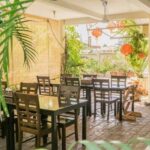Chinese New Year, also known as the Spring Festival, is a significant and cherished holiday in Chinese culture. It is a time for families to come together, honor ancestors, and welcome good luck and fortune for the upcoming year. One of the key aspects of this festive celebration is home decoration. From vibrant red lanterns to auspicious couplets, Chinese New Year decorations fill homes with an atmosphere of joy and prosperity.
In Chinese culture, the Lunar New Year holds immense importance. It represents a fresh start and an opportunity for renewal. The act of decorating one’s home during this time is believed to invite positive energy and ward off evil spirits. Each decor item holds symbolic meanings rooted in historical traditions and folklore.
One of the most iconic Chinese New Year decorations is the red lantern. These lanterns are not only visually striking but are also believed to bring good luck and dispel negative energy. Another essential decor item is “Fu” calligraphy scrolls which feature blessings and wishes for wealth, health, and happiness in the new year. Door couplets are also displayed on entrances to invite prosperity while deterring evil spirits.
The tradition of decorating homes during Chinese New Year goes beyond mere aesthetics – it carries deep cultural significance as a way to honor traditions, pass down heritage, and create a warm environment for family gatherings. By exploring different traditional decorations and their meanings, we can gain a deeper understanding of the vibrant tradition that surrounds Chinese New Year decoration.
Traditional Chinese New Year Decorations
Chinese New Year is a time of joy and celebration, filled with vibrant traditions and customs that have been passed down through generations. One of the most important aspects of Chinese New Year is the decoration of homes with auspicious symbols that are believed to bring good luck, fortune, and prosperity for the year ahead. In this section, we will delve into some of the traditional Chinese New Year decorations and explore their symbols and meanings.
Red Lanterns: Lighting up the Festive Atmosphere
One of the most iconic decorations during Chinese New Year is the red lantern. These lanterns are hung in both indoor and outdoor spaces, illuminating the surroundings with a warm glow. Red lanterns symbolize good luck and are believed to ward off evil spirits. The color red itself holds great significance in Chinese culture as it is associated with happiness, joy, and celebration.
Fu Calligraphy Scrolls: Displaying Blessings and Prosperity
Another common decoration during Chinese New Year is Fu calligraphy scrolls. The word “fu” means “blessings” or “good fortune” in Chinese. These scrolls are typically displayed prominently on walls or doors, often in black ink on red paper. They feature beautifully written characters that convey well wishes for prosperity, harmony, and success in the new year.
Door Couplets: Inviting Good Fortune
Door couplets, also known as chunlian or Spring Festival couplets, play an essential role in Chinese New Year decorations. These poetic verses are usually written on long strips of red paper and affixed to both sides of a doorframe. Door couplets typically consist of two lines each that balance each other in terms of meaning or rhythm. They serve as an invitation for blessings to enter the home while deterring evil spirits.
Paper Cuttings: Auspicious Symbols and Wishes
Paper cuttings are intricate designs created by cutting out delicate patterns from red paper. These cutouts often depict auspicious symbols such as Chinese characters for luck, longevity, and happiness, as well as zodiac animals associated with the coming year. Paper cuttings are believed to bring good luck and can be displayed on windows, walls, or doors to add a festive touch to the home.
By incorporating these traditional Chinese New Year decorations into our homes, we invite positive energy, good fortune, and prosperity into our lives for the year ahead. The vibrant colors and symbolic meanings of these decorations create a warm and festive atmosphere that cultivates joy and harmony among family and friends. In the next section, we will explore must-have Chinese New Year decorations that can fill our homes with prosperity during this auspicious time.
Filling Your Home with Prosperity
Chinese New Year is a time of celebration and renewal, and one of the most important aspects of this vibrant tradition is home decoration. Filling your home with auspicious symbols and meaningful decorations is believed to bring prosperity, luck, and happiness for the year ahead. In this section, we will explore some must-have Chinese New Year decorations that will infuse your home with prosperity.
- New Year Plants: One popular way to bring luck and wealth into your home during Chinese New Year is by incorporating specific plants. For example, kumquat trees are often displayed as they symbolize prosperity and good fortune. Peonies are also a common choice, representing growth and happiness.
Pussy willow branches are believed to attract wealth. By having these plants in your home, you not only add a touch of natural beauty but also invite positive energy into your living space. - Red Envelopes: Another essential element of Chinese New Year decoration is the red envelope or “hongbao.” These envelopes are filled with monetary gifts and given to family members, friends, and colleagues as blessings for the coming year.
The color red is considered extremely auspicious in Chinese culture and symbolizes good luck and warding off evil spirits. By spreading blessings through red envelopes, you share prosperity with those around you while also infusing your home with positive energy. - Nianhua Paintings: Nianhua paintings have a long history in Chinese culture and are an integral part of New Year celebrations. These traditional folk art paintings often depict mythical figures or scenes inspired by ancient folklore and legends. Displaying Nianhua paintings in your home not only adds cultural richness but also brings blessings for the year ahead. Each painting tells a unique story and serves as a reminder of our connection to our heritage.
By incorporating these must-have Chinese New Year decorations into your home, you create an ambiance filled with prosperity, luck, and blessings for the upcoming year. These decorations not only add beauty and vibrancy to your living space but also serve as a reminder of the rich cultural tradition behind Chinese New Year. So, bring out the kumquat trees, red envelopes, and Nianhua paintings, and embrace the spirit of Chinese New Year in your own home.
DIY Chinese New Year Decorations
Chinese New Year is a time of celebration and festivity, and what better way to embrace the spirit of the holiday than by infusing your own personal touch and creativity into your home decorations? DIY Chinese New Year decorations allow you to not only add a unique flair to your festive ambiance but also create meaningful memories with your loved ones as you craft together.
In this section, we will explore a few popular DIY Chinese New Year decoration ideas that you can try.
- Paper Lanterns: One of the most iconic symbols of Chinese New Year is the red lantern. Making your own paper lanterns can be a fun and rewarding project. Start by gathering materials such as red or gold paper, scissors, glue, and string. You can find various templates or patterns online to guide you through the process.
Once you’ve cut out the lantern shape, fold along the designated lines and secure with glue or tape. Add a string at the top for hanging, and voila. You have your very own homemade paper lanterns. - Paper Folding: Origami is another traditional art form that can be incorporated into your Chinese New Year decorations. Lucky stars and goldfish are popular origami shapes that symbolize good luck and wealth respectively. Find tutorials online that provide step-by-step instructions on how to create these beautiful paper ornaments. You can use decorative paper in auspicious colors like red and gold to add an extra festive touch.
- Spring Festival Couplets: Door couplets, also known as “chunlian” in Mandarin, are an essential part of Chinese New Year decor as they bring good fortune and protection to the household. Crafting your own spring festival couplets allows you to express your creativity while incorporating traditional blessings into your home.
Choose sturdy red paper or cardstock for longevity, and then write or paint auspicious phrases in black ink on each strip of paper. Hang them on either side of your front door for an authentic Chinese New Year touch.
By infusing your own personal touch and creativity into your DIY Chinese New Year decorations, you can create a warm and festive ambiance in your home. These handmade decorations not only add a unique charm but also reflect the spirit of the holiday. Remember, the most important thing is to enjoy the process and have fun with your loved ones as you craft together. Happy decorating.
Modern Chinese New Year Decoration Trends
In recent years, there has been a growing trend of balancing traditional Chinese New Year decorations with contemporary style. While the significance and symbolism of traditional decorations remain important, many people are finding ways to incorporate modern design elements into their festive decor. This section will explore some of the modern Chinese New Year decoration trends that allow individuals to embrace tradition while expressing their personal style and taste.
Incorporating Traditional Symbols into Minimalist Home Decor
One popular trend in modern Chinese New Year decoration is incorporating traditional symbols into minimalist home decor. Instead of overwhelming the space with an abundance of red and gold, individuals are opting for a more streamlined and subtle approach.
For example, instead of using large red lanterns, one may choose to hang smaller lanterns in various shades of red and combine them with sleek minimalistic furniture. By combining traditional symbols with clean lines and simple designs, individuals can create a harmonious blend between tradition and contemporary aesthetics.
Feng Shui Tips for Harmony and Positive Energy
Another trend is incorporating Feng Shui principles when arranging furniture and decorations for Chinese New Year. Feng Shui is the ancient Chinese practice of harmonizing one’s environment to promote positive energy flow and well-being.
Many people believe that arranging furniture and decorations in specific ways can invite good luck and fortune into their homes during this auspicious time. Incorporating Feng Shui elements such as mirrors to reflect light or positioning decorations in certain areas based on the Bagua map can bring balance and harmony to the space while maintaining a modern look.
Non-Traditional Color Schemes and Materials
While red and gold have long been associated with Chinese New Year, some individuals are exploring non-traditional color schemes for a modern twist. Incorporating colors such as pastels or jewel tones can add vibrancy while still capturing the celebratory spirit of the festival.
Additionally, using unconventional materials or textures, such as metallic accents or sleek glass decorations, can provide a contemporary touch to the traditional Chinese New Year decor. Experimenting with different colors and materials allows for creativity and personal expression while retaining the essence of the festival.
Decorating Beyond the Home
Chinese New Year is not only celebrated within households but is also widely observed in public spaces. From Chinatowns to temples, these locations are adorned with vibrant decorations that display the rich cultural heritage of Chinese New Year. Public spaces during this festive season come alive with lanterns, colorful banners, and traditional performances that create a truly immersive experience for both locals and tourists alike.
Chinatowns around the world are known for their elaborate Chinese New Year decorations. These lively neighborhoods burst with red lanterns and ornate paper cuttings that line the streets, creating a joyful atmosphere. Each Chinatown has its own unique style of decorations, incorporating traditional symbols of good luck and fortune. Visitors can explore bustling night markets filled with delicious food stalls and soak in the festivities through various events such as lion dances and dragon parades.
Temples play a significant role in Chinese New Year celebrations as well. These sacred spaces are adorned with intricate decorations that reflect religious teachings and folklore. Ornamental flowers and plants symbolizing prosperity and growth decorate temple entrances, inviting worshippers to start the new year on an auspicious note. Inside the temples, visitors can witness various cultural performances like traditional music concerts or martial arts demonstrations, adding an element of artistic beauty to the festival atmosphere.
If you’d like to immerse yourself in grandeur Chinese New Year decor beyond your home, there are several must-visit locations globally. The annual Lantern Festival in Pingxi District, Taiwan showcases breathtaking lantern displays where sky lanterns illuminate the night sky as wishes are released into the air.
Singapore’s Chinatown transforms into an enchanting wonderland during Chinese New Year with illuminated streets and eye-catching displays at iconic landmarks like the Buddha Tooth Relic Temple. The Spring Festival couplets adorning doorways add a touch of elegance, while Chinatown markets offer an immersive shopping experience for festive goodies.
| Must-Visit Location | Country/City |
|---|---|
| Pingxi Lantern Festival | Taiwan, Pingxi District |
| Singapore Chinatown | Singapore |
| China Towns in Major Cities | Various countries (e.g., New York City, London, Sydney) |
Preserving Chinese New Year Decorations
Preserving the rich heritage of Chinese New Year decorations is crucial for passing down these traditions to future generations. These vibrant and meaningful decorations not only enhance the festive atmosphere but also hold deep cultural significance. Museums and exhibitions play a vital role in showcasing the historical artifacts and educating the public about the importance of preservation.
One example is the Hong Kong Heritage Museum, which houses a collection of traditional Chinese New Year decorations. The museum not only showcases the beauty of these decorations but also provides insights into their history and cultural significance. Visitors can learn about the various materials used, such as paper cuttings, lanterns, and calligraphy scrolls, as well as their symbolic meanings.
In addition to museums, many cultural organizations are working tirelessly to preserve Chinese New Year decorations. One such organization is the Society for Preservation, Research, and Development of Traditional Festivals (SPRD), based in Beijing. The SPRD aims to document and safeguard traditional festivals, including Chinese New Year celebrations, by conducting research, organizing exhibitions, and advocating for their preservation.
| Organization | Location | Mission |
|---|---|---|
| Hong Kong Heritage Museum | Hong Kong | Showcasing and preserving traditional Chinese New Year decorations |
| Society for Preservation, Research, and Development of Traditional Festivals (SPRD) | Beijing | Documenting and safeguarding traditional festivals including Chinese New Year celebrations |
It is not only organizations that are involved in preserving Chinese New Year decorations; individuals can also play a part in conservation efforts. Proper storage and care are essential in maintaining the condition of these delicate decorations. Tips for preservation include keeping decorations away from direct sunlight to prevent fading, storing them in acid-free tissue paper or boxes to avoid degradation, and handling them with clean hands to prevent oils and dirt from damaging the materials.
Preserving Chinese New Year decorations not only helps us reconnect with our cultural heritage but also ensures that future generations can continue to celebrate this important festival. By supporting museums, cultural organizations, and taking care of our own collections, we can contribute to safeguarding these beautiful traditions for years to come.
Final Thoughts
As the Chinese New Year approaches, it is time to embrace the vibrant tradition of Chinese New Year decoration and create a warm and festive ambiance in our homes. The importance of Chinese New Year in Chinese culture cannot be overstated, as it is a time for family reunions, reflection, and celebration. One of the key elements of this celebration is the significance of home decorations for welcoming good luck and fortune.
Throughout this article, we have explored the various traditional Chinese New Year decorations and their symbols and meanings. From red lanterns that light up the festive atmosphere to fu calligraphy scrolls that display blessings and prosperity, each decoration holds significance in bringing positive energy into our lives. Door couplets invite good fortune while deterring evil spirits, and paper cuttings depict auspicious symbols and wishes for happiness.
To truly fill our homes with prosperity during this joyous occasion, there are must-have Chinese New Year decorations that we can include. New year plants such as kumquat, peonies, and pussy willow symbolize growth, luck, and wealth. Red envelopes spread blessings and monetary gifts to loved ones, further spreading joy throughout the festivities. Nianhua paintings highlight traditional folklore while bringing blessings for the year ahead.
It is essential to remember that decorating for Chinese New Year goes beyond our own homes. Chinatowns and temples are adorned with lanterns and colorful decorations during this time. Traditional performances and parades add grandeur to the celebrations. Experiencing these public spaces not only allows us to immerse ourselves in the spirit of Chinese New Year but also offers inspiration for our own décor.
In conclusion, celebrating Chinese New Year with a warm and festive ambiance is a wonderful way to honor this vibrant tradition. By embracing the spirit of Chinese New Year decoration in our homes, we invite good luck and fortune into our lives while creating lasting memories with loved ones. As we embark on this journey of celebration together, may the Chinese New Year bring prosperity and joy to all.
Frequently Asked Questions
How to decorate your home for Chinese New Year?
Decorating your home for Chinese New Year is an exciting opportunity to embrace the vibrant and festive spirit of the celebration. There are several key elements to consider when decorating for this auspicious occasion. One popular tradition is to hang red lanterns or string lights at the entrance of your home, symbolizing luck and prosperity.
Red is believed to ward off evil spirits and bring good fortune, so incorporating this color into your decorations is essential. Additionally, floral arrangements such as cherry blossoms or mandarin oranges can be displayed as they represent new beginnings and abundance respectively. Finally, it’s common to adorn windows and doorways with intricate paper cutouts featuring symbolic designs like double happiness characters or zodiac animals.
What do people decorate their house with during Chinese New Year?
During Chinese New Year, people decorate their houses with various auspicious items that carry symbolic meanings. One significant decoration is the “Fu” character, which means good luck or blessings. It’s often placed upside down on doors or walls as a play on words because “upside down” in Chinese sounds similar to “arrive.”
This suggests that good fortune is coming into one’s home. Another popular item is the paper-cut window decorations known as “Chunlian.” These colorful ornaments feature phrases conveying wishes for prosperity, longevity, and happiness in the upcoming year.
How are living rooms decorated for Chinese New Year?
Living rooms are an integral part of Chinese New Year decorations as this where families gather to celebrate and exchange greetings during the festive season. To create a joyous atmosphere, living rooms are typically adorned with couplets called “Duilian”, which consist of rhythmic parallel phrases written on red paper or scrolls expressing good wishes for the new year ahead. It’s also customary to place a tray filled with fresh fruit on the family altar or coffee table symbolizing abundance and health.
Moreover, it’s common practice to display traditional Chinese paintings that portray signs of wealth, such as fish swimming upstream or phoenixes amidst blooming flowers, adding an artistic touch to the overall decor. Ultimately, the goal is to create a warm and inviting ambiance for family and friends to gather, exchange gifts, and enjoy traditional festivities.

I’m thrilled to be your companion on this exciting journey through the world of home decor and design. With a passion for turning houses into homes and a keen eye for the finer details, I’m here to help you transform your living spaces into beautiful, functional, and meaningful havens.





